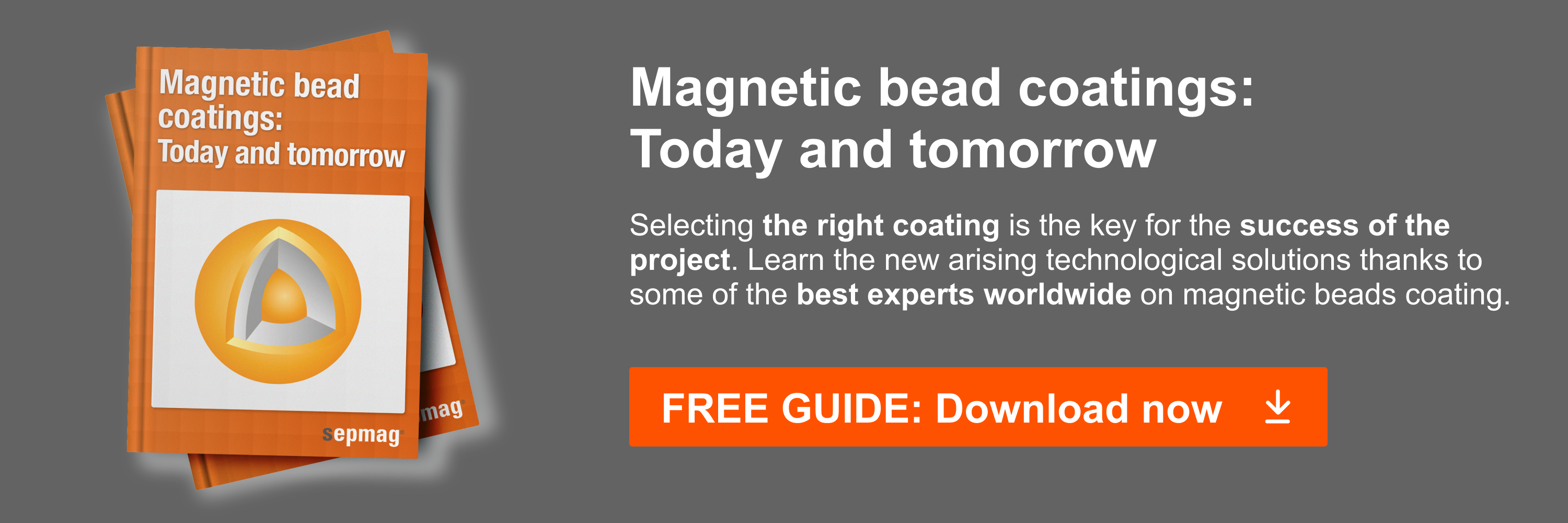Magnetic beads are available with a large variety of surface coatings. One of the coatings are the Tosyl activated beads. This post is describing the handling and advantages of the use of Tosyl activated magnetic beads in chemiluminescent immunoassays.
At this moment Tosyl activated beads are available from different companies. Tosyl activated beads can be ordered in different sizes, from 1.0 to 5.0 µm with different functional group densities. The handling of Tosyl activated beads is easy and the beads are ready to use; no pre-activation is necessary. Furthermore, the Tosyl activated beads are known for an excellent reproducibility when producing different batches.
Tosylactivated groups on the magnetic beads can react with sulfhydryl groups and also with amine groups. At pH values around 7.0 to 8.0 the sulfhydryl group reaction occurs. At higher pH values (e.g. 8.5 to 9.5) the reaction with amine groups can occur. The high pH coupling is the method that is used the most when developing beads for immunoassays. A typical example of a protocol of coupling antibodies to Tosyl activated beads is described below. Besides antibodies tosyl activated beads can also be coupled with other proteins.
If you are interested in magnetic bead coatings, download SEPMAG's newest free guide, Magnetic bead coatings: Today and Tomorrow. You can download it through the following link:
The preparation phase before using the Tosyl activated beads is easy; beads are washed 2 or 3 times with the coupling buffer. Examples of coupling buffers are 100 mM phosphate buffer (PB) pH 7.4 for sulfhydryl group coupling or a 100 mM Borate or Carbonate buffer pH 9.5 for amine group coupling. Washing of the beads should be done using a good quality magnetic separator and sonication can be used when re-suspending the beads by using e.g. a sonication bath.
When the coupling process starts the beads should have a concentration preferably higher than 10 mg/mL. Our lab routinely uses a concentration 30 mg/mL beads during the coupling phase. Coupling of the antibodies is done overnight at 37 degrees C using a continuous rotation (overnight incubation is 12 to 18 hours, but needs to be established in a much tighter time period when developing beads for your application). Note that the rotation speed or using a rocking roller can cause influence the coat process. At lower temperatures the coupling time will be longer; 24 to 48 hours. The coupling of the antibodies is a stable covalent bond.
The coat concentration of the antibodies needs to be optimized when developing an immunoassay; normal coating concentrations range from 5 to 20 µg/mg of beads. The high capacity for binding antibodies, or other proteins, is an advantage of the Tosyl activated beads. After the coupling period the beads can be washed 2 or 3 times with a washing buffer containing 0.5% BSA, but this is not obligatory. Blocking of the beads is the fastest at 37 degrees C for 1 hour using a blocking buffer that preferably has the same base composition as the storage buffer. PBS pH 7.4 containing 0.5% BSA is used for many immunoassays as blocking buffer. When blocking at e.g. 4 degrees C the incubation time is recommended to be overnight. A major advantage of the Tosyl activated beads is the low non-specific binding of proteins to the beads.
The last step after blocking the antibody coated beads is the addition of the storage buffer. This buffer can be the same as the blocking buffer, but a preservative such as sodium azide or MIT/CMIT should be added to extend the shelf life of the stock preparation. Standard storage concentration of the antibody coated beads is 10 mg/mL. In immunoassays beads are diluted to a working concentration using a dilution buffer. Again this buffer can be the same as the blocking or storage buffer, but this needs to be established. Working concentration of beads coated with antibodies typically range from 0.5 to 2.0 mg/mL.
It is clear that working with Tosyl activated magnetic beads really could improve the development of your magnetic particle based immunoassay.
Related articles:
- Rapid biofunctionalization of magnetic beads with function-spacer-lipid constructs
- Surface Attenuation for High Sensitivity Assays
- The 4 today’s surfaces for magnetic beads coating
About the author: Dr. Michael Jansen – Novel Biomarkers Catalyst Lab
 Dr. Michael Jansen has more than 11 years of experience in the medical device industry. In 2012 Michael founded NBCL together with two partners; NBCL is focused on the development and commercialization of novel biomarkers. Before starting NBCL Michael was Senior Project Leader R&D at Future Diagnostics, heading a team within the R&D department responsible for assay development.
Dr. Michael Jansen has more than 11 years of experience in the medical device industry. In 2012 Michael founded NBCL together with two partners; NBCL is focused on the development and commercialization of novel biomarkers. Before starting NBCL Michael was Senior Project Leader R&D at Future Diagnostics, heading a team within the R&D department responsible for assay development.
Michael was responsible for the development and validation of assays for the detection of different analytes in biological matrices, on large fully automated immunoassay analysers, point of care platforms and manual micro titer plate assays (ELISA). The development of assays was in the area of fertility, infectious diseases, autoimmune, diabetes, cardiac, thyroid and bone metabolism. Michael held two post-doc positions; one at Wageningen university at the Industrial Microbiology group and at the University of Groningen at the high-throughput screenings facility. Michael holds a PhD in Biochemistry from the University of Groningen.
For more information visit: nbcl.nl





